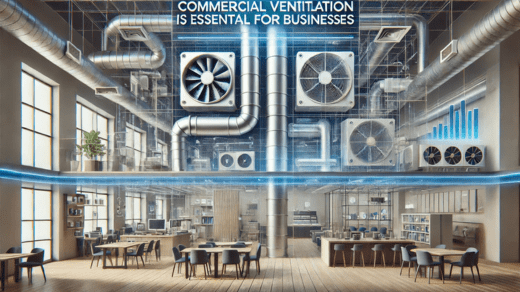Advanced Ventilation Solutions for Commercial Real Estate
Benefits of Implementing Upgraded Ventilation Systems in Commercial Buildings
Upgrading ventilation systems in commercial buildings can yield a multitude of advantages for both occupants and property owners. Enhanced ventilation promotes better indoor air quality, crucial for maintaining a healthy and productive work environment. Improved air circulation helps mitigate the buildup of pollutants, allergens, and airborne contaminants, reducing the risk of respiratory issues and promoting overall well-being among building occupants.Furthermore, investing in upgraded ventilation systems can lead to increased energy efficiency, lowering operational costs and contributing to sustainability efforts. Modern ventilation technologies offer optimized airflow control, allowing for precise regulation based on occupancy levels and building requirements. By maximizing energy efficiency through upgraded ventilation, commercial property owners can create a more comfortable environment for occupants while simultaneously reducing their carbon footprint and operating expenses.
Commercial Ventilation systems in commercial buildings offer enhanced indoor air quality and improved airflow control. Upgraded ventilation can reduce pollutants, allergens, and operational costs, promoting a healthier and more sustainable work environment for building occupants.
Importance of Indoor Air Quality in Commercial Real Estate
Indoor air quality holds paramount significance in the realm of commercial real estate. It directly influences the health, comfort, and productivity of occupants within these spaces. Poor indoor air quality can lead to an array of issues ranging from respiratory problems and allergies to decreased focus and efficiency among employees. With the majority of individuals spending a significant portion of their time indoors, ensuring high-quality indoor air through proper ventilation systems is not just a luxury but a necessity in the competitive landscape of commercial real estate.Moreover, in today’s environmentally conscious society, the emphasis on indoor air quality aligns with sustainability efforts. Efficient ventilation systems not only enhance air quality but also contribute to energy efficiency within commercial buildings. By reducing energy consumption through optimized ventilation solutions, property owners can not only create a healthier indoor environment but also lower operational costs and lessen their environmental footprint. A well-ventilated commercial space not only engenders a healthy and pleasant atmosphere but also signifies a commitment to sustainable practices, a factor that is becoming increasingly important in the eyes of tenants and stakeholders in the commercial real estate sector.
Key Factors to Consider When Choosing Ventilation Solutions for Commercial Properties
When selecting ventilation solutions for commercial properties, one crucial factor to consider is the size and layout of the building. Proper ventilation needs to be tailored to the specific dimensions of the space to ensure efficient airflow distribution. Additionally, the type of business or activities conducted within the commercial property will impact the ventilation requirements. For instance, a restaurant will need a different ventilation system compared to an office building due to varying levels of pollutants and odors.Another key consideration is the sustainability and energy efficiency of the ventilation system. Opting for eco-friendly solutions not only reduces the environmental impact but also helps in cutting down long-term operational costs. Look for ventilation systems with energy-efficient features such as programmable settings, variable speed controls, and advanced filtration options to promote better indoor air quality while minimizing energy consumption.
Innovative Technologies for Enhanced Ventilation in Commercial Spaces
One of the cutting-edge technologies revolutionizing ventilation systems in commercial spaces is the use of advanced smart sensors. These sensors are designed to detect changes in air quality and adjust ventilation levels accordingly, ensuring optimal indoor air quality at all times. By continuously monitoring factors like humidity, CO2 levels, and particulate matter, smart sensors enable a more responsive and efficient ventilation system that adapts to the specific needs of the building and its occupants.Another innovative technology making waves in the realm of commercial ventilation is energy recovery ventilation (ERV) systems. ERV systems are designed to exchange the energy contained in the outgoing stale air with the incoming fresh air, significantly reducing the energy required to heat or cool the ventilation air. By harnessing the thermal energy present in the exhaust air stream, ERV systems help improve energy efficiency in commercial buildings while also enhancing indoor air quality. This technology not only reduces operational costs but also contributes to sustainability efforts by minimizing energy consumption and reducing the environmental impact of commercial properties.
Maximizing Energy Efficiency with Modern Ventilation Systems
Modern ventilation systems play a crucial role in enhancing energy efficiency within commercial buildings. By incorporating advanced technologies such as energy-efficient motors, intelligent controls, and heat recovery systems, these systems can effectively regulate air quality while minimizing energy consumption. This results in reduced operational costs for building owners and tenants, making it a sustainable investment in the long run.The integration of modern ventilation systems not only offers energy savings but also contributes to a healthier indoor environment. By controlling air circulation effectively, these systems help in maintaining optimal temperature levels, reducing humidity, and eliminating pollutants. This not only enhances the comfort of occupants but also supports productivity and overall well-being within the commercial space.
Natural Home Solutions offer cutting-edge ventilation systems for commercial buildings, focusing on energy efficiency and air quality. These systems incorporate advanced technologies to regulate air circulation effectively, ensuring optimal temperature levels and reducing pollutants for a healthier indoor environment.
Optimizing Ventilation Design for Different Types of Commercial Buildings
When it comes to optimizing ventilation design for various types of commercial buildings, one must consider the unique characteristics and requirements of each space. For office buildings, a balance between energy efficiency and indoor air quality is essential. Implementing a ventilation system that can efficiently circulate fresh air while minimizing energy consumption is key to creating a comfortable and productive work environment. Additionally, incorporating smart technologies that allow for automated control and monitoring of ventilation systems can further enhance efficiency and occupant satisfaction.In retail spaces, the focus shifts towards creating a welcoming and inviting atmosphere for customers. Ventilation design should prioritize not only air quality but also the distribution of airflow to ensure a pleasant shopping experience. By strategically placing ventilation units to avoid drafts and hot spots, retailers can maintain a comfortable climate throughout the store. Moreover, incorporating air purification systems can help eliminate odors and allergens, further enhancing the overall shopping environment.
Addressing Common Ventilation Challenges in Commercial Real Estate
Ensuring optimal ventilation in commercial real estate can be a complex task, often presenting challenges that need to be carefully addressed. One common issue faced by many commercial properties is inadequate air circulation, leading to stagnant air and potential issues with indoor air quality. This can result in discomfort for occupants and even health concerns if not effectively resolved.Additionally, improper ventilation design or outdated systems may contribute to inconsistent temperature control within a building. Temperature variations can impact the comfort levels of employees and visitors, affecting productivity and overall satisfaction. Addressing these challenges requires a comprehensive approach that considers the specific needs of the commercial space and implements tailored ventilation solutions to promote a healthy and comfortable indoor environment.
Ensuring Compliance with Ventilation Regulations and Standards
Meeting ventilation regulations and standards is a crucial aspect of maintaining a healthy and safe indoor environment in commercial buildings. These regulations are put in place to ensure that proper air quality is maintained, preventing the buildup of harmful pollutants and contaminants that can negatively impact occupants’ health. By adhering to these guidelines, property owners can demonstrate their commitment to providing a conducive workspace that promotes well-being and productivity.To ensure compliance with ventilation regulations and standards, commercial property owners should work closely with experienced professionals who have a deep understanding of building codes and industry requirements. Conducting regular inspections and assessments of ventilation systems can help identify any issues or deficiencies that need to be addressed promptly. By staying proactive in monitoring and maintaining ventilation systems, property owners can not only meet regulatory requirements but also enhance the overall quality of indoor air for a healthier and more comfortable work environment.
The Cost-Effectiveness of Investing in High-Quality Ventilation Solutions
Investing in high-quality ventilation solutions for commercial properties may initially seem like a significant expense. However, the long-term cost-effectiveness of such investments cannot be overstated. By ensuring a consistently healthy indoor environment, these systems can lead to increased employee productivity and fewer sick days, ultimately contributing to cost savings for businesses. Additionally, energy-efficient ventilation solutions can help lower utility bills and reduce the carbon footprint of commercial buildings, aligning with sustainability goals and potentially qualifying for rebates or incentives.Moreover, high-quality ventilation systems can prolong the lifespan of a building’s infrastructure by minimizing the risk of moisture-related damage and mold growth. Addressing these issues proactively through proper ventilation can prevent costly repairs and renovations down the line, saving businesses from unexpected financial burdens. In the competitive landscape of commercial real estate, properties equipped with top-notch ventilation solutions also hold a strategic advantage, attracting tenants who prioritize a healthy and comfortable work environment.
Future Trends in Ventilation Technology for Commercial Real Estate
Innovations in ventilation technology for commercial real estate are rapidly evolving to meet the increasing demand for energy-efficient and sustainable solutions. One of the emerging trends is the integration of smart ventilation systems that utilize sensors and advanced algorithms to optimize airflow based on real-time data. These systems can adjust ventilation rates according to occupancy levels, indoor air quality, and weather conditions, enhancing overall comfort while minimizing energy consumption.Another trend shaping the future of ventilation technology in commercial properties is the development of modular ventilation units that offer greater flexibility in installation and maintenance. These modular systems can be easily customized to fit diverse building layouts and requirements, allowing for more efficient use of space and resources. Additionally, advancements in filtration technologies are improving indoor air quality by capturing a wider range of pollutants and allergens, promoting healthier and more productive indoor environments.

